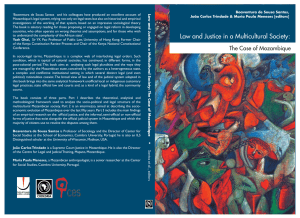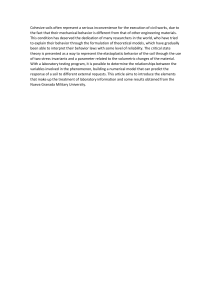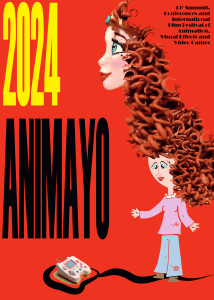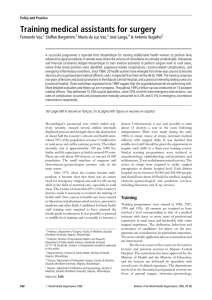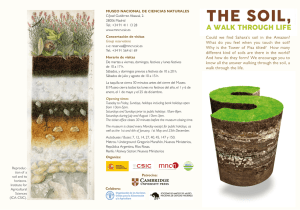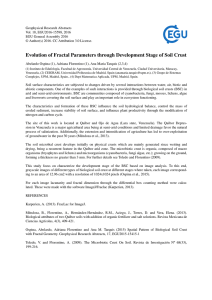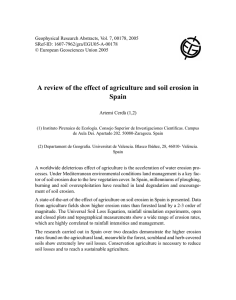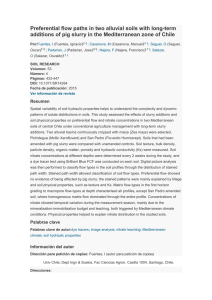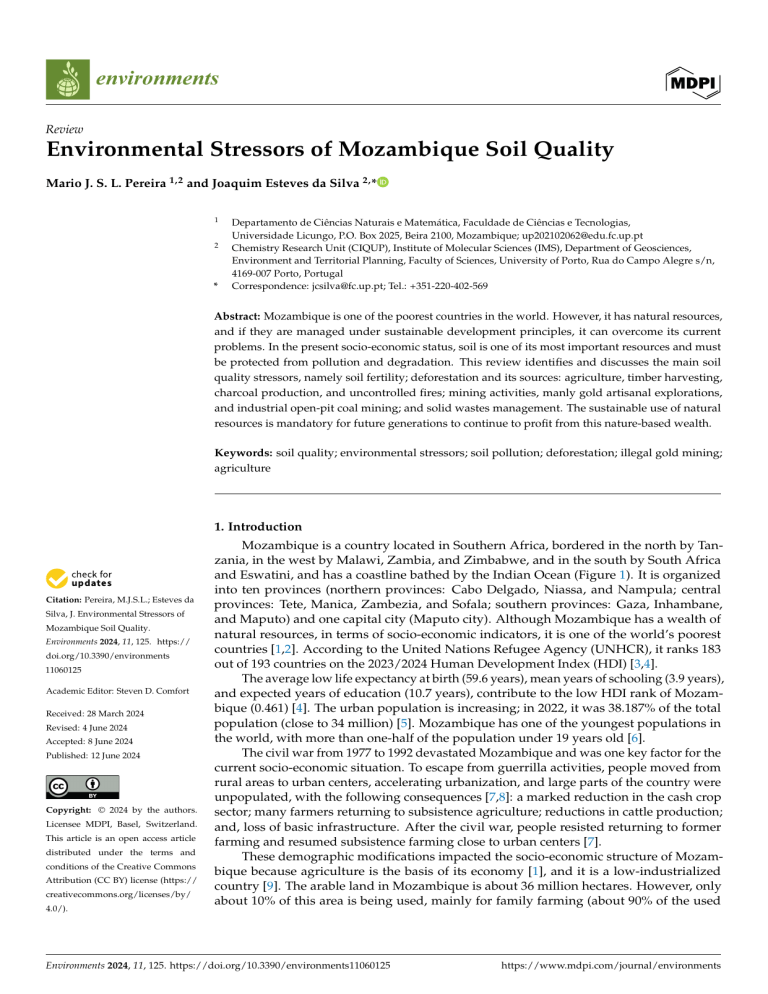
environments Review Environmental Stressors of Mozambique Soil Quality Mario J. S. L. Pereira 1,2 and Joaquim Esteves da Silva 2, * 1 2 * Departamento de Ciências Naturais e Matemática, Faculdade de Ciências e Tecnologias, Universidade Licungo, P.O. Box 2025, Beira 2100, Mozambique; up202102062@edu.fc.up.pt Chemistry Research Unit (CIQUP), Institute of Molecular Sciences (IMS), Department of Geosciences, Environment and Territorial Planning, Faculty of Sciences, University of Porto, Rua do Campo Alegre s/n, 4169-007 Porto, Portugal Correspondence: jcsilva@fc.up.pt; Tel.: +351-220-402-569 Abstract: Mozambique is one of the poorest countries in the world. However, it has natural resources, and if they are managed under sustainable development principles, it can overcome its current problems. In the present socio-economic status, soil is one of its most important resources and must be protected from pollution and degradation. This review identifies and discusses the main soil quality stressors, namely soil fertility; deforestation and its sources: agriculture, timber harvesting, charcoal production, and uncontrolled fires; mining activities, manly gold artisanal explorations, and industrial open-pit coal mining; and solid wastes management. The sustainable use of natural resources is mandatory for future generations to continue to profit from this nature-based wealth. Keywords: soil quality; environmental stressors; soil pollution; deforestation; illegal gold mining; agriculture 1. Introduction Citation: Pereira, M.J.S.L.; Esteves da Silva, J. Environmental Stressors of Mozambique Soil Quality. Environments 2024, 11, 125. https:// doi.org/10.3390/environments 11060125 Academic Editor: Steven D. Comfort Received: 28 March 2024 Revised: 4 June 2024 Accepted: 8 June 2024 Published: 12 June 2024 Copyright: © 2024 by the authors. Licensee MDPI, Basel, Switzerland. This article is an open access article distributed under the terms and conditions of the Creative Commons Attribution (CC BY) license (https:// creativecommons.org/licenses/by/ 4.0/). Mozambique is a country located in Southern Africa, bordered in the north by Tanzania, in the west by Malawi, Zambia, and Zimbabwe, and in the south by South Africa and Eswatini, and has a coastline bathed by the Indian Ocean (Figure 1). It is organized into ten provinces (northern provinces: Cabo Delgado, Niassa, and Nampula; central provinces: Tete, Manica, Zambezia, and Sofala; southern provinces: Gaza, Inhambane, and Maputo) and one capital city (Maputo city). Although Mozambique has a wealth of natural resources, in terms of socio-economic indicators, it is one of the world’s poorest countries [1,2]. According to the United Nations Refugee Agency (UNHCR), it ranks 183 out of 193 countries on the 2023/2024 Human Development Index (HDI) [3,4]. The average low life expectancy at birth (59.6 years), mean years of schooling (3.9 years), and expected years of education (10.7 years), contribute to the low HDI rank of Mozambique (0.461) [4]. The urban population is increasing; in 2022, it was 38.187% of the total population (close to 34 million) [5]. Mozambique has one of the youngest populations in the world, with more than one-half of the population under 19 years old [6]. The civil war from 1977 to 1992 devastated Mozambique and was one key factor for the current socio-economic situation. To escape from guerrilla activities, people moved from rural areas to urban centers, accelerating urbanization, and large parts of the country were unpopulated, with the following consequences [7,8]: a marked reduction in the cash crop sector; many farmers returning to subsistence agriculture; reductions in cattle production; and, loss of basic infrastructure. After the civil war, people resisted returning to former farming and resumed subsistence farming close to urban centers [7]. These demographic modifications impacted the socio-economic structure of Mozambique because agriculture is the basis of its economy [1], and it is a low-industrialized country [9]. The arable land in Mozambique is about 36 million hectares. However, only about 10% of this area is being used, mainly for family farming (about 90% of the used Environments 2024, 11, 125. https://doi.org/10.3390/environments11060125 https://www.mdpi.com/journal/environments Environments 2024, 11, x FOR PEER REVIEW Environments 2024, 11, 125 2 of 11 2 of 11 tares. However, only about 10% of this area is being used, mainly for family farming (about 90% of the used arable land) in small agricultural fields (smaller than 2 hectares) arable land) in small agricultural than 2 hectares) [10]. Agriculture employs [10]. Agriculture employs more thanfields 67% (smaller of the population (with the total Mozambique subsistence, and contributes about about population million [1,5]), mainly more thanbeing 67% about of the34population (with the for total Mozambique populationtobeing 22% of the GDP [10]. 34 million [1,5]), mainly for subsistence, and contributes to about 22% of the GDP [10]. Figure1.1.Mozambique Mozambique map with its provinces, adapted reference Figure map with its provinces, adapted fromfrom reference [11]. [11]. Geographically,Mozambique Mozambiqueisislocated locatedin in aa high-risk zone for Geographically, for extreme extremeweather weatherevents (cyclones, droughts, and and floods) andand is particularly change [1,3]. events (cyclones, droughts, floods) is particularlyvulnerable vulnerable to to climate climate change [1,3]. Cycled natural disasters afflict Mozambique, which has a limited responsiveness Cycled natural disasters afflict Mozambique, which has a limited responsiveness capability, capability, aggravating humanitarian crises, hampering development, and creating sub-public aggravating humanitarian crises, hampering development, and creating substantial Indeed,inasFigure shown2,inthese Figure 2, these affect stantial health challenges (Figure 2) [12]. health public challenges (Figure 2) [12]. Indeed, as shown affect higher percenthigher of theAdditionally, population. Additionally, since 2017, terrorist attacks in the ages ofpercentages the population. since 2017, terrorist attacks in the northern districts northern districts forcedofthe migration of local inhabitants to other safer places. forced the migration local inhabitants to other safer places. Mozambique’s natural resources are are the the basisbasis for its growth projections in Mozambique’s natural resources foreconomic its economic growth projections in renewable energy sources, mineral resources, agroecological the years, namely thefollowing following years, namely renewable energy sources, mineral resources, agroecological regions, and wildlife resources [1]. [1]. However, usingusing sustainable strategies is regions,and andforest forest and wildlife resources However, sustainable strategies is mandatory to ensure that future generations will continue profiting from Mozambique’s mandatory to ensure that future generations will continue profiting from Mozambique’s soil, air. soil,water, water,and and air. The lack of large industrial areas and intensive agriculture in Mozambique have The lack of large industrial areas and intensive agriculture in Mozambique have resulted in the absence of accumulated toxic pollutants areas in the country [9]. However, resulted in the absence of accumulated toxic pollutants areas in the country [9]. However, overpopulation in the main cities, without infrastructures, has resulted in specific polluoverpopulation in the main cities, without infrastructures, has resulted in specific pollution problems [9,13]. Moreover, some unsustainable and unregulated practices may release toxic pollutants, consequently constituting stressors that may impact soil quality. The release into the environment of mercury from artisanal gold mining is a typical example of highly polluting activity [14,15]. Deforestation for illegal timber commerce [16], conversion of Environments 2024, 11, 125 The release into the environment of mercury from artisanal gold mining is a typical example of highly polluting activity [14,15]. Deforestation for illegal timber commerce [16], conversion of forest soil into crop cultures [17], and charcoal production [18] are examples of activities that degrade soil quality. This review analyzes the literature on environmental stressors that degrade soil 3 of 11 quality in Mozambique. Soil quality is directly related to good-quality and high food yield, which is vital in a country like Mozambique. Indeed, in Mozambique’s current development stage, it is vital that soil quality is maintained and improved. It is time to forest into croppractices culturesto[17], and that charcoal production of activities followsoil sustainable ensure the current fertile[18] soil are willexamples produce enough that degrade soil quality. food for present and future generations. Figure 2. 2. The events and people affected in Mozambique between 1956 1956 Figure The number numberofofextreme extremeweather weather events and people affected in Mozambique between and 2020, adapted from reference [12]. and 2020, adapted from reference [12]. 2. Soil Fertility This review analyzes the literature on environmental stressors that degrade soil quality MozambiqueSoil soils are characterized by lowtofertility, which and limits food production in Mozambique. quality is directly related good-quality high food yield, which [19]. The mineralogy of Mozambique soils is characterized by kaolinite iron alumiis vital in a country like Mozambique. Indeed, in Mozambique’s currentand development num oxides and hydroxides, which have the lowest cation exchangeable capacity (CEC) stage, it is vital that soil quality is maintained and improved. It is time to follow sustainable agriculturally promising of the common soil minerals [19]. In a 2006 study in four practices to ensure that the current fertile soil will produce enough food for present and agroecological zones of Mozambique, the CEC ranged from 0.4 to 14.5 cmolc kg−1, with future generations. seventy-five percent of the samples having less than 7.5 cmolc kg−1, conferring on these soils low-to-moderate fertility [19]. The CEC can be classified as follows [20]: very low, <5 2. Soil Fertility cmolc kg−1; low, 5–10 cmolc kg−1; moderate, 10.1–20 cmolc kg−1; high, 20.1–40 cmolc kg−1; Mozambique soils are characterized by low fertility, which limits food production [19]. and very high, >40 cmolc kg−1. Also, these minerals possess high phosphorous adsorption The mineralogy of Mozambique soils is characterized by kaolinite iron and aluminum capacities, like kaolinite and oxides and hydroxides of iron and aluminum, which conoxides and hydroxides, which have the lowest cation exchangeable capacity (CEC) of the tribute to reducing the nutrient availability for plants. common soil minerals [19]. In a 2006 study in four agriculturally promising agroecological A critical nutrient for maize production, which is the main crop −in1 the country, is zones of the CEC from in 0.4this to 14.5 cmol[19]. with seventy-five c kg In, 1983, nitrogen, Mozambique, and Mozambique soils ranged are deficient nutrient a study − 1 percent of the samples having less than 7.5 cmol kg , conferring on these low-toc showed that the loss rates of NPK were high (21–40 kg/ha for N, 8–15 kg/ha for P, soils and 21– −1 moderate fertility [19]. The CEC can be classified as follows [20]: very low, <5 cmol c kg ; 40 kg/ha for K) and that the total nitrogen loss rate increased between 1983 and 2000 (in − 1 − 1 − 1 low, 5–10 cmol ; moderate, cmol ; high, 20.1–40 cmolsystems and very c kg7 and c kg c kg ; with the range between 11 kg/ha) 10.1–20 [21]. Maize and cassava are the cropping −1 . Also, these minerals possess high phosphorous adsorption capacities, high, >40 cmol kg c the highest nutrient depletion in small- and large-scale cropping systems [4]. like kaolinite and oxides and hydroxides of iron and aluminum, which contribute to reducing the nutrient availability for plants. A critical nutrient for maize production, which is the main crop in the country, is nitrogen, and Mozambique soils are deficient in this nutrient [19]. In 1983, a study showed that the loss rates of NPK were high (21–40 kg/ha for N, 8–15 kg/ha for P, and 21–40 kg/ha for K) and that the total nitrogen loss rate increased between 1983 and 2000 (in the range between 7 and 11 kg/ha) [21]. Maize and cassava are the cropping systems with the highest nutrient depletion in small- and large-scale cropping systems [4]. Another factor that affects soil quality is agricultural practices, namely excessive soil tillage with no soil cover [22]. Conventional tillage provokes soil degradation, with consequent fertility depletion, mainly through soil organic matter oxidation, disruption of the soil structure, and a decrease in aggregate stability [22]. Moreover, soil erosion Environments 2024, 11, 125 4 of 11 by wind and rainwater directly results from conventional tillage practices. Conservation agriculture follows three principles: (i) minimal soil disturbance, (ii) crop residue retention, and (iii) crop diversification through rotation or intercropping [22,23]. The use of cover crops also reduces erosion and contributes to carbon sequestration by increasing soil organic matter. Moreover, there is an increase in water retention and reduced evaporation from the soil, which is critical for Mozambique’s rainy and dry seasons. In Mozambique, slash-and-burn agricultural systems are a common practice worldwide and one of the main livelihoods in family farming [24]. These agricultural practices include cutting, burning, and farming different forest areas in rotation, with long forest fallow for 50 to 100 years, to allow for forest and soil restoration [24]. Currently, shorter forest fallow periods are being used as a form of deforestation, with all the associated problems related to economic, social, and environmental lack of sustainability [24]. 3. Deforestation Mozambique made a series of commitments with several United Nations organizations related to the conservation of its forest and its ecosystem services, namely [12] Aichi Targets of the United Nations Convention on Biological Diversity (UNCBD), the REDD + (Reducing Emissions from Deforestation and forest Degradation) mechanism of the United Nations Framework Convention on Climate Change (UNFCCC), the Land Degradation Neutrality (LDN) initiative of the United Nations Convention to Combat Desertification (UNCCD), and the Sustainable Development Goals (SDGs), mainly SDG target 15.3 dedicated to the restoration of degraded land and soil. These commitments align with the recognition that Mozambique’s growth is tied to the sustainable management of its natural resources. Nevertheless, deforestation has an ongoing impact in Mozambique, and the analysis of the land cover change between 2001 and 2016 showed a significant forest loss of about 1.3 Mha, mainly due to conversion into cropland [12]. In the south of Mozambique, in the biodiversity hotspot of the Licuáti Forest Reserve, the annual rate of deforestation between 1990 and 2001 was 0.8%, and that between 2013 and 2013 was 2.3% [25]. In an area of 7500 km2 of the Manica province, the center of Mozambique, between 2007 and 2010, biomass was lost at a rate of 2.8 ± 1.9% per year. Small-scale agriculture was the direct cause of 46 ± 17% of the total loss, construction and miscellaneous activities were responsible for 24 ± 11% of it, charcoal production caused 18 ± 9% of loss, logging was the cause of 9 ± 5% of it, and commercial agriculture resulted in 3 ± 2% loss [26]. The leading causes of deforestation are agriculture field expansion, charcoal production, fuelwood extraction, and timber harvesting [25]. Among other ecosystem services lost due to deforestation, such as timber and water provision, biodiversity, and carbon sequestration, soil quality is particularly affected, and loss of agricultural productivity and desertification are menaces. 3.1. Agriculture Before its independence from Portugal in 1975, the agricultural sector of Mozambique was dominated by big farms that produced crops for exportation, medium and big farms dedicated to extensive livestock farming, oilseeds, and tobacco, and that produced products for local consumption. After independence, the land became state property, and many private agricultural companies were nationalized, resulting in the massive abandonment of foreign investors and technicians with the consequent economic disarticulation of production and consequent crisis. The civil war, which lasted from 1977 to 1992, further complicated this product/economic disruption scenario. Nevertheless, Mozambique has significant potential for agriculture because of its tropical climate and enormous extensions of arable land, and its rivers and lakes spread throughout the territory, with water all over the year [27]. However, low agricultural productivity is observed due to traditional agronomic technologies, a lack of an efficient advisory public service, and low-yield seeds [27]. Environments 2024, 11, 125 5 of 11 Most of the population is dedicated to subsistence agriculture in small family farms. Between 2000 and 2010, two state programs were introduced, PROAGRI (National Program for the Agrarian Development) and the Green Revolution, to stimulate private and foreign investment to modernize agriculture [27]. A joint program between Mozambique, Brazil, and Japan (PROSAVANA program) to develop agriculture in the 6 million ha of land in the Nacala corridor (provinces of Nampula, Niassa, and Zambézia) was created to mainly produce soy, cotton, and maize [27,28]. The “National Biofuels Strategy and Policy” opened up opportunities for large biofuel production projects. Among others, a project is expected to accommodate a sugarcane/ethanol plantation with 30,000 hectares of the Massingir minor town, close to the Massingir dam reservoir, to be used for irrigation [29]. A 400 ha organic coffee plantation involving 1600 farmers in Chimanimani National Park (Manica province) started in the year 2020 (Agrotur project) [30]. Although many other agriculture megaprojects are being implemented, in 2020, the number of big farmyards was 873, less than 1% of the 4.3 million agricultural and livestock farms that exist in Mozambique [31]. Moreover, cultivated land made up 5.5 Mha, 5.5% of which was used pesticides, 8.8% of which was used manure, 7.8% of which was used chemical fertilizers, and 9.1% of which was used water [31]. Meanwhile, many forest areas are being changed for planting different crops, such as corn, soybeans, sesame, cabbage, lettuce, kale, sweet potatoes, carrots, beans, bananas, and fruit plants, among others [32]. This process of land reconcentration in Mozambique is an ongoing strategy to increase food production, enough for the country and for export [16,33]. However, there are many conflicts between big agricultural companies and local inhabitants who have given up their small family farms or still have their property [34], and this process’s social, economic, and environmental sustainability should be assessed. From the environmental point of view, and specifically concerning soil quality, the risks of soil degradation resulting from intensive monoculture farming are significant, and sustainable agricultural practices should be implemented at a large scale. 3.2. Timber Harvesting The forest inventory from 2005 estimated a forest cover of 40 Mha (51% of the country), and about 67% of that area corresponds to productive forest, while the rest falls into conservation areas and topological or ecologically inaccessible land [35]. Four types of forests exist in Mozambique: mopane and mecrusse forests, semi-deciduous forests (including miombo), and semi-evergreen forest (including gallery forest) [36]. Between 2012 and 2022, Mozambique lost 4.03 Mha of tree cover, equivalent to a 14% decrease in tree cover since 2000 and 1.43 Gt of equivalent carbon dioxide emissions [37]. Logging has been a steady driver of deforestation in Mozambique, and this practice has been carried out by companies and by the population when looking for construction materials and firewood [38]. Besides the legal timber harvesting carried out by companies that possess legal authorization (land title–DUATs), there is illegal harvesting and trafficking of the most precious tree species in the north of the country, across the Ruvuma River, into Tanzania [39,40]. In Africa, Mozambique is a significant timber exporter, with the following five trees of top commercial interest: Afzelia quanzensis, Pterocarpus angolensis, Millettia stuhlmanii, Combretum imberbe, Swartzia madagascariensis [36]. To re-establish the commercial tree plantation sector, the Government of Mozambique created the National Reforestation Strategy (NRS) in 2009 to increase the forest plantation area from 24,000 ha to 1 million ha by 2030 [40]. The NRS had an investment of USD 2 to 4 billion that could only be achieved with international investors. This project was in line with the country’s economic development based on its natural wealth, i.e., the agriculture and forest sectors. 3.3. Charcoal Production Woodland-occupied areas are the dominant land cover type in Mozambique, corresponding to 51% of the total country area [41]. Woodlands are responsible for several Environments 2024, 11, 125 6 of 11 ecosystem services, and the most important are charcoal, firewood, woody construction materials, thatching grass, food, medicinal plants, and livestock forage [41]. One of Mozambique’s most essential ecosystem services is charcoal production, with an estimated market value of USD400 million annually [42]. Wood fuels account for 81% of energy consumption, with charcoal being the dominant fuel in urban centers [43]. Fuelwood is mainly consumed in rural areas, and charcoal production is driven by urban demand [18]. Depending on the region, charcoal production is responsible for a significant fraction of deforestation and agricultural expansion [18]. In wet woodlands, charcoal production is a secondary product to agriculture, while in semiarid regions, the opposite is observed [18]. Nevertheless, charcoal production is a critical component in carbon dioxide emission accountability in the current carbon balance towards neutrality assessments. The most desirable tree for charcoal production is Mopane (Colophospermum mopane) [41,42]. Its straight trunk and its dense timber (1.02–1.14 g cm−3 ) produce charcoal with high caloric power in kilns with trees felled around the kilns’ place (with an average cutting area of 0.28 ha) [18]. Kilns are located in areas with suitable trees and access to trails and roads, producing an average of 104 sacks measuring 15 kg [18,25]. Although charcoal production is a form of cash income for impoverished rural people, in some areas, it is the only livelihood possible, and the net result may be less beneficial to local producers and the environment (due to the degradation of natural resources). Indeed, intermediates are responsible for the large-scale export of charcoal to cities and earn the main financial benefits [41]. 3.4. Uncontrolled Fires Natural and anthropogenic fires are a driving ecological force maintaining savanna ecosystems worldwide [42]. Most rural communities use fire to manage land fields [42]. Uncontrolled fires in Mozambique have been created mainly by the population to open agricultural fields and also to hunt some wild animals. Excessive cutting of plants and uncontrolled fires degrade soils, destruct forests, and cause a loss of habitats. According to [43], fires destroy the habitat and kill insects that pollinate the flowers of crops, causing their agricultural yield to decrease and altering the food chain (insects are food for other animals). According to some authors [44], slash and burn practices are believed to be one of the causes of uncontrolled fires in Mozambique. However, other reasons, such as pasture renewal, hunting, charcoal production, and harvesting honey, can also play an important role [32]. This practice of uncontrolled fires degrades soil, such as by causing increased soil bulk density, and reducing water infiltration into the soil; it also threatens soil microorganisms that help in the decomposition of organic matter and the porosity, aeration, infiltration, and drainage of soils [45]. Flora and fauna present in the burned ecosystem will be affected, and generally, fire always has several negative effects on soil biota [46]. 4. Mining Mozambique has abundant mineral resources, including fossil fuels, such as natural gas, thermal, and metallurgical coal, and essential reserves of non-fuel minerals, particularly minerals and heavy sand deposits [32]. The extraction of mineral resources such as coal, gold, and heavy sand is carried out through extensive exploitation by companies and, on a small scale and usually illegally, by individuals (artisanal extraction). Environmental damages are expected if mining activities are carried out without impact minimization strategies [47]. The negative impacts of mineral extraction include water pollution, soil degradation, deforestation, air pollution, and changes in the balance of some ecosystems. Artisanal extraction of gold also causes soil erosion and pollution, resulting in soil unsuitable for food production. One of the mining activities widely practiced in the province of Manica is the extraction of alluvial gold by companies and artisanal mining [48]. About 20,000 people are involved Environments 2024, 11, 125 7 of 11 in artisanal gold mining in the center of Mozambique [49]. This artisanal and small-scale gold mining (ASGM) is a form of informal economic activity [50], but it is the only source of income for otherwise jobless people [51,52]. Considering this social and economic role, ASGM is supposed to become regularized instead of prohibited [51,52]. Artisanal gold mining consists of removing large quantities of sediments, and raw sediments and processing waste cover surface soils rich in minerals and nutrients, altering the natural characteristics of the soils and leaving them unable to support agricultural practice [37,48]. Also, river waters used in agriculture irrigation become polluted. The occupation of many hectares of land by companies to extract gold has been registered, and some agricultural fields belonging to small agricultural producers have occurred [53]. A critical problem associated with artisanal gold mining is the use of mercury in the final extraction step [14,15]. Liquid mercury is used for amalgamation, in which the ores’ remaining components separate gold. Mercury in gold extraction compromises the health of people involved in artisanal mining activities and the environment, specifically polluting of river waters, groundwater, and soil [14,15]. In the northwest of Mozambique, in the province of Tete, potential environmental impacts are related to open-pit coal mining megaprojects [54,55]. Physico-chemical analysis of the water from the Revúbuè and Moatize Rivers in the surroundings of the coal mining at Moatize district (Tete) showed contamination by iron and magnesium [54]. Another study on the water, sediments, and soil from the rivers Zambezi, Revúboè, Moatize, and Muarazi showed that all rivers were contaminated with arsenic, chromium, and manganese during the wet season, and arsenic, chromium, manganese, lead, and nickel in the dry season [55]. Also, the soils from the Moatize and the tributary Murrowgoze rivers were highly polluted [55]. 5. Solid Wastes The accelerated urbanization of Mozambique during the 1977 to 1992 civil war increased the amount and variety of municipal solid wastes (MSWs) [56]. This demographic shift aggravated the problem of municipal solid waste management because, in Mozambique, wastes are, under the best scenario, deposited in dumpsites without treatment [56–58]. Data from 2004 showed that waste generation in the capital, Maputo, where the highest production of waste is registered, amounted to 1 kg per day per person in the inner city and 0.56 kg per day per person in suburban areas—the 1.7 million inhabitants of Maputo produced a total 676,000 kg/day of MSWs and, by adding industrial waste, the total reached 980,000 kg/day [57]. In 2014 Maputo and the adjoining city of Matola, the population reached 2.1 million, and it is expected to rise to more than 3 million by 2025 [58]. This situation is similar to that in all urban places in Mozambique but with a smaller dramatic dimension [59]. In a 2017 survey, 46% of the population burned MSWs, 23% buried it, and 19% disposed of their MSWs on open land [56]. Macroscopically, the composition of MSWs is as follows (with weight in % in the Maputo city and suburbs, respectively) [57]: organics, 68 and 29%; paper, 12 and 4%; plastic, 10 and 4%; metals, 4 and 1%; glass, 2% (in the city). Taking into consideration the high percentage of organic matter of MSWs, composting strategies should be implemented, and compost should be used to improve Mozambique soil quality that is poor in organic matter. In suburban and rural places, and considering the fledgling economic status of Mozambique, the circular economy is the status quo, and the population reuses materials considered wastes in a city environment or a rich country [59,60]. Consequently, the problem of MSW management occurs in the city centers and places where waste is dumped. The existence of unmanaged dumpsites raises critical health risks to the neighboring population due to the severe local environmental pollution. The decline in soil quality is a direct consequence of the areas where wastes are deposited in open pits [13,57]. The HuleneB waste dump, measuring 17 hectares, is located 7 km from the Maputo city center, and is one example of this problem, where ecological degradation of soils due to contamination Environments 2024, 11, 125 8 of 11 with potentially toxic elements is well known [13,61]. All the Mozambique municipalities have one or more open dumps where all the urban waste is deposited untreated [61]. The Mozambique Law of Waste Management recognizes solid waste management’s waste hierarchy and the three Rs principle (reduce, reuse, and recycle) [61]. Well-known scavengers apply some of these principles. Residual recycling of materials (like plastics, paper, aluminum, and organic waste into compost) exists. However, it is an informal activity due to the low demand for these materials by industries that process them [61]. Although the composition of MSWs suggests that a large percentage of the MSWs could be recycled by composting, data from 2017 showed that only about 1% is recycled or recovered [57]. The political, technical, and economic challenges in MSW management for Mozambique Governance are enormous but mandatory. The public health and environmental risks due to the uncontrolled dumping of waste in growing cities are enormous. 6. Conclusions Mozambique’s current environmental soil problems are caused by intense pressure on natural resources, both by the population and companies in various areas of exploration. The population needs training in the following priority areas: sustainable agricultural and forestry practices, which protect and improve soil quality, and non-polluting technologies for artisanal gold extraction, which protect human and environmental health. Companies should follow international standards for environmental quality to become economically and socially sustainable in Mozambique. Sustainable development management of natural resource exploration is mandatory to ensure that future generations continue enjoying Mozambique’s natural wealth. This is particularly critical for Mozambique because more than half its population is young, under 19 years old. Also, considering this demographic characteristic of Mozambique, the success of sustainable development will depend on implementing educational politics to increase environmental literacy in the population. Author Contributions: Conceptualization—M.J.S.L.P. and J.E.d.S.; writing—original draft preparation, M.J.S.L.P. and J.E.d.S.; writing—review and editing, M.J.S.L.P. and J.E.d.S.; supervision, J.E.d.S.; funding acquisition, M.J.S.L.P. and J.E.d.S. All authors have read and agreed to the published version of the manuscript. Funding: This research was funded by FCT—R&D Unit CIQUP (UIDB/000081/2020) (https://doi. org/10.54499/UIDB/00081/2020) and Associated Laboratory IMS (LA/P/0056/2020). Data Availability Statement: No new data were created or analyzed in this study. Data sharing is not applicable to this article. Conflicts of Interest: The authors declare no conflicts of interest. References 1. 2. 3. 4. 5. 6. Report: Voluntary National Review of Agenda 2030 for Sustainable Development, Mozambique. VNR2020—Voluntary National Report: Our Commitment to Sustainable Development for All. 2020. Available online: https://planipolis.iiep.unesco.org/en/20 20/voluntary-national-review-agenda-2030-sustainable-development (accessed on 30 May 2024). World Food Programme. Mozambique Annual Country Report 2022—Country Strategic Plan 2022–2026. 2022. Available online: https://www.wfp.org/operations/mz02-mozambique-country-strategic-plan-2022-2026 (accessed on 30 May 2024). The UN Refugee Agency. Annual Results Report 2022 Mozambique. UNHCR, 3 of May, 2023. Available online: www.unhcr.org (accessed on 17 January 2024). Human Development Report 2023/2024. Breaking the Gridlock. Reimagining Cooperation in a Polarized World; United Nations Development Programme: New York, NY, USA, 2024. World Bank. Urban Population (% of total population)—Mozambique. 2022. Available online: https://data.worldbank.org/ indicator/SP.URB.TOTL.IN.ZS?locations=MZ (accessed on 30 May 2024). United States Census Bureau. Available online: https://www.census.gov/programs-surveys/international-programs/data/ population-vulnerability/mozambique.html (accessed on 30 May 2024). Environments 2024, 11, 125 7. 8. 9. 10. 11. 12. 13. 14. 15. 16. 17. 18. 19. 20. 21. 22. 23. 24. 25. 26. 27. 28. 29. 30. 31. 9 of 11 Folmer, E.C.R.; Geurts, P.M.H.; Francisco, J.R. Assessment of soil fertility depletion in Mozambique. Agric. Ecosyst. Environ. 1998, 71, 159–167. [CrossRef] Perin, V.P. Plantation designs in northern Mozambique: Development, struggles and (re)compositions facing the ProSAVANA program. Tapuya: Latin American Science. Technol. Soc. 2023, 6, 2252122. [CrossRef] Batista, M.J.; Quentala, L.; Dias, R.; Ramalho, E.; Fernandes, J.; Milisse, D.; Manhiça, V.; Ussene, U.; Cune, G.R.; Daudi, E.X.; et al. Geochemical characterisation of soil of Beira city, Mozambique: Geogenic origin and relation with land cover. J. Geochem. Explor. 2018, 187, 184–200. [CrossRef] Marassiro, M.J.; Romarco de Oliveira, M.L.; Pereira, G.P. Family farming in Mozambique: Characteristics and challenges. Res. Soc. Dev. 2021, 10, e22110615682. [CrossRef] Cianciullo, S.; Attorre, F.; Trezza, F.R.; Rezende, M.; Ntumi, C.; Campira, J.; Munjovo, E.T.; Timane, R.D.; Riccardi, T.; Malatesta, L. Analysis of land cover dynamics in Mozambique (2001–2016). Rend. Lincei. Sci. Fis. E Nat. 2023, 34, 81–92. [CrossRef] Mugabe, V.A.; Gudo, E.S.; Inlamea, O.F.; Kitron, U.; Ribeiro, G.S. Natural disasters, population displacement and health emergencies: Multiple public health threats in Mozambique. BMJ Glob. Health 2021, 6, e006778. [CrossRef] Bernardo, B.; Candeias, C.; Rocha, F. Soil Risk Assessment in the Surrounding Area of Hulene-B Waste Dump, Maputo (Mozambique). Geosciences 2022, 12, 290. [CrossRef] Abdelaal, A.; Sultan, M.; Abotalib, A.Z.; Bedair, M.; Krishnamurthy, R.V.; Elhebiry, M. Emerging mercury and methylmercury contamination from new artisanal and small-scale gold mining along the Nile Valley, Egypt. Environ. Sci. Pollut. Res. 2023, 30, 52514–52534. [CrossRef] [PubMed] Leuenberger, A.; Winkler, M.S.; Cambaco, O.; Cossa, H.; Kihwele, F.; Lyatuu, I.; Zabre, H.R.; Farnham, A.; Macete, E.; Munguambe, K. Health impacts of industrial mining on surrounding communities: Local perspectives from three sub-Saharan African countries. PLoS ONE 2021, 16, e0252433. [CrossRef] Bey, A.; Meyfroidt, P. Improved land monitoring to assess large-scale tree plantation expansion and trajectories in Northern Mozambique. Environ. Res. Commun. 2021, 3, 115009. [CrossRef] Temudo, M.P.; Silva, J.M.N. Agriculture and forest cover changes in post-war Mozambique. J. Land Use Sci. 2012, 7, 425–442. [CrossRef] Sedano, F.; Silva, J.A.; Machoco, R.; Meque, C.H.; Sitoe, A.; Ribeiro, N.; Anderson, K.; Ombe, Z.A.; Baule, S.H.; Tucker, C.J. The impact of charcoal production on forest degradation: A case study in Tete, Mozambique. Environ. Res. Lett. 2016, 11, 094020. [CrossRef] [PubMed] Maria, R.M.; Yost, R. A Survey of Soil Fertility Status of Four Agroecological Zones of Mozambique. Soil Sci. 2006, 171, 902–914. [CrossRef] de Varennes, A. Produtividade dos Solos e Ambiente; Escolar Editora: Lisboa, Portugal, 2003; ISBN 972-592-156-9. Stoorvogel, J.J.; Smaling, E.M.A. Assessment of Soil Nutrient Depletion in Sub-Saharan Africa: 1983–2000; The Winand Staring Centre: Wageningen, The Netherlands, 1990; Report 28, 4 Volumes; Volume 1, ISSN 0924-3062. Chichongue, O.; van Tol, J.; Ceronio, G.; Preez, C.D. Effects of Tillage Systems and Cropping Patterns on Soil Physical Properties in Mozambique. Agriculture 2020, 10, 448. [CrossRef] Muatendauafa, A.S.R.; Francisco, A.; Zuarica, F.J.E.; Alface, L.A.; João, X.S. Importance of Conservation Agriculture in Soil Preservation in Vanduzi District in Mozambique. RECIMA21-Rev. Científica Multidiscip. 2023, 4, 1–20. Serrani, D.; Cocco, S.; Cardelli, V.; D’Ottavio, P.; Rafael, R.B.A.; Feniasse, D.; Vilanculos, A.; Fernández-Marcos, M.L.; Giosué, C.; Tittarelli, F.; et al. Soil fertility in slash and burn agricultural systems in central Mozambique. J. Environ. Manag. 2022, 322, 116031. [CrossRef] [PubMed] Tokura, W.; Matimele, H.; Smit, J.; Hoffman, M.T. Long- term changes in forest cover in a global biodiversity hotspot in southern Mozambique’, Bothalia 2020, 50, a1. 50. [CrossRef] Ryan, C.M.; Berry, N.J.; Joshi, N. Quantifying the causes of deforestation and degradation and creating transparent REDD+ baselines: A method and case study from central Mozambique. Appl. Geogr. 2014, 53, 45–54. [CrossRef] Rosário, N.M. Agronegócio em Moçambique: Uma breve análise da situação de estrangerização do agronegócio. Soc. E Territ.–Natal 2019, 31, 183–200. [CrossRef] Zaehringer, J.G.; Atumane, A.; Berger, S.; Eckert, S. Large-scale agricultural investments trigger direct and indirect land use change: New evidence from the Nacala corridor, Mozambique. J. Land Use Sci. 2018, 13, 325–343. [CrossRef] Nhantumbo, I.; Salomão, A. Biofuels, Land Access and Rural Livelihoods in Mozambique; International Institute for Environment and Development (IIED): London, UK, 2010; ISBN 978-1-84369-744-2. Mozambique: Chimanimani Organic Coffee Project with 1600 Farmers to be Largest Plantation. Available online: https://clubofmozambique.com/news/mozambique-chimanimani-organic-coffee-project-with-1600-farmers-to-be-largestplantation-photos-210098/ (accessed on 17 January 2024). MADER. Inquérito Agrário Integrado 2020: Marco Estatístico. República de Moçambique. Ministério da Agricultura e Desenvolvimento Rural. Direção de Planificação e Políticas. Moçambique. 2021. Available online: https://www.agricultura.gov.mz/ wp-content/uploads/2021/06/MADER_Inquerito_Agrario_2020.pdf (accessed on 17 January 2024). Environments 2024, 11, 125 32. 33. 34. 35. 36. 37. 38. 39. 40. 41. 42. 43. 44. 45. 46. 47. 48. 49. 50. 51. 52. 53. 54. 55. 56. 57. 58. 10 of 11 Serra, C.M.; Dondeyne, S.; Durang, T. (Coordenadores) O Meio Ambiente em Moçambique: Notas Para Reflexão Sobre Notas Para Reflexão Sobrea Situação Actual e os Desafios Para o Futuro a Situação Actual e os Desafios Para o Futuro. Grupo Ambiente—Parceiros de Cooperação. Maputo, Moçambique Maputo, Moçambique. Junho 2013. Available online: https://biblioteca.biofund.org.mz/biblioteca_virtual/o-meio-ambiente-em-mocambique-notas-para-reflexao-sobre-asituacao-actual-e-os-desafios-para-o-futuro/ (accessed on 17 January 2024). Bruna, N. Land of Plenty, Land of Misery: Synergetic Resource Grabbing in Mozambique. Land 2019, 8, 113. [CrossRef] Land of Plenty, Land of But a Few. Available online: https://terradealguns.divergente.pt/en/ (accessed on 17 January 2024). Marzoli, A. Inventário Florestal Nacional. Projecto de Avaliação Integrada das Florestas de Moçambique (AIFM); DNTF: Maputo, Mozambique, 2007. Available online: https://biblioteca.biofund.org.mz/wp-content/uploads/2019/01/1548752956-F226 .National%20Forest%20Inventory_Mozambique.pdf (accessed on 17 January 2024). Joaquim-Meque, E.; Lousada, J.; Liberato, M.L.R.; Fonseca, T.F. Forest in Mozambique: Actual Distribution of Tree Species and Potential Threats. Land 2023, 12, 1519. [CrossRef] Global Forest Watch. Available online: https://www.globalforestwatch.org/dashboards/country/MOZ/?category=forestchange&lang=en&location=WyJjb3VudHJ5IiwiTU9aIl0=&map=eyJjYW5Cb3VuZCI6dHJ1ZX0= (accessed on 19 January 2024). Garcia, M.F.R.; Bandeira, R.R.; Lise, F. Influências ambientais na qualidade de vida em Moçambique. Rev. Eletrônica Acolhendo A Alf. Nos Países De Língua Port. 2009, III, 69–93. Lukumbuzya, K.; Sianga, C. Overview of the Timber Trade in East and Southern Africa: National Perspectives and Regional Trade Linkages; TRAFFIC and WWF; TRAFFIC: Cambridge, UK, 2017; 53p. Mbanze, A.A.; Shuangao, W.; Mudekwed, J.; Dias, C.R.; Sitoe, A. The rise and fall of plantation forestry in northern Mozambique. Trees For. People 2022, 10, 100343. [CrossRef] Woollen, E.; Ryan, C.M.; Baumert, S.; Vollmer, F.; Grundy, I.; Fisher, J.; Fernando, J.; Luz, A.; Ribeiro, N.; Lisboa, S.N. Charcoal production in the Mopane woodlands of Mozambique: What are the trade-offs with other ecosystem services? Phil. Trans. R. Soc. B 2016, 371, 20150315. [CrossRef] [PubMed] Shaffer, L.J. Indigenous fire use to manage savanna landscapes in southern Mozambique. Fire Ecol. 2010, 6, 43–59. [CrossRef] Mahamane, M.; Zorrilla-Miras, P.; Verweij, P.; Sitoe, A.; Ryan, C.; Patenaude, G.; Grundy, I.; Nhantumbo, I.; Metzger, M.; Ribeiro, N.; et al. Understanding Land Use, Land Cover and Woodland-Based Ecosystem Services Change, Mabalane, Mozambique. Energy Environ. Res. 2017, 7, 1–22. [CrossRef] Stewart, B.A.; Robinson, C.A. Are agroecosystems sustainable in semiarid regions? Adv. Agron. 1997, 60, 191–228. [CrossRef] Moyo, S.; O’Keefe, P.; Sill, M. The Southern African Environment: Profiles of the SADC Countries; Earthscan: New York, NY, USA, 2013; ISBN 9781853831713. Certini, G.; Moya, D.; Lucas-Borja, M.E.; Mastrolonardo, G. The impact of fire on soil-dwelling biota: A review. For. Ecol. Manag. 2021, 488, 118989. [CrossRef] Nwadialor, I.J. Minimizing the impact of mining activities for sustainable mined-out area conservation in Nigeria. FUTY J. Environ. 2011, 6, 68–80. [CrossRef] Raso, E.F.; Savaio, S.S.; Mulima, E.P. Impact of artisanal gold mining on agricultural soils: Case of the district of Manica, Mozambique. Rev. Verde 2022, 17, 44–50. [CrossRef] Dondeyne, S.; Ndunguru, E.; Rafael, P.; Bannerman, J. Artisanal mining in central Mozambique: Policy and environmental issues of concern. Resour. Policy 2009, 34, 45–50. [CrossRef] Mujere, N.; Isidro, M. Impacts of Artisanal and Small-Scale Gold Mining on Water Quality in Mozambique and Zimbabwe. In Impact of Water Pollution on Human Health and Environmental Sustainability; McKeown, A.E., Bugyi, G., Eds.; IGI Global: Hershey, PA, USA, 2016; Chapter 5; pp. 101–119. [CrossRef] Hilson, G.; Mondlane, S.; Hilson, A.; Arnall, A.; Laing, T. Formalizing artisanal and small-scale mining in Mozambique: Concerns, priorities and challenges. Resour. Policy 2021, 71, 102001. [CrossRef] Dondeyne, S.; Ndunguru, E. Artisanal gold mining and rural development policies in Mozambique: Perspectives for the future. Futures 2014, 62, 120–127. [CrossRef] Júnior, A.; Ibraimo, M.; Mosca, J. Exploração artesanal de ouro em Manica. Obs. Meio Rural 2016, 38, 1–20. Available online: https://omrmz.org/observador/or-38-exploracao-artesanal-de-ouro-em-manica/ (accessed on 17 January 2024). Macie, A.E.A.; Bacci, D.C. Coal Mining at Moatize, Tete Province, Northwest of Mozambique: A Socio Environmental Analysis. Int. J. Eng. Res. Technol. 2017, 6, 433–442. Marove, C.A.; Sotozono, R.; Tangviroon, P.; Tabelin, C.B.; Igarashi, T. Assessment of soil, sediment and water contaminations around open-pit coal mines in Moatize, Tete province, Mozambique. Environ. Adv. 2022, 8, 100215. [CrossRef] Gani, A.H.A.; Aderoju, O.M.; Dias, A.G.; Monjane, A.A.R. Improving the attitude and reaction towards municipal solid waste management in Mozambique. WIT Trans. Ecol. Environ. 2020, 247, 47–56. [CrossRef] Sallwey, J.; Hettiarachchi, H.; Hulsmann, S. Challenges and opportunities in municipal solid waste management in Mozambique: A review in the light of nexus thinking. AIMS Environ. Sci. 2017, 4, 621–639. [CrossRef] Tvedten, I.; Candiracci, S. “Flooding our eyes with rubbish”: Urban waste management in Maputo, Mozambique. Environ. Urban. 2018, 30, 631–646. [CrossRef] Environments 2024, 11, 125 59. 60. 61. 11 of 11 Tas, A.; Belon, A. A Comprehensive Review of the Municipal Solid Waste Sector in Mozambique: Background Documentation for the Formulation of Nationally Appropriate Mitigation Actions in the Waste Sector in Mozambique; Carbon Africa Limited: Maputo, Nairobi, 2014. Available online: www.carbonafrica.co.ke (accessed on 17 January 2024). Ferrari, K.; Gamberini, R.; Rimini, B. The waste hierarchy: A strategic, tactical and operational approach for developing countries: The case study of Mozambique. Int. J. Sustain. Dev. Plan 2016, 11, 759–770. [CrossRef] Villa, F.; Vinti, G.; Vaccari, M. Appropriate solid waste management system in Quelimane (Mozambique): Study and design of a small-scale center for plastic sorting with wastewater treatment. Waste Dispos. Sustain. Energy 2022, 4, 49–62. [CrossRef] [PubMed] Disclaimer/Publisher’s Note: The statements, opinions and data contained in all publications are solely those of the individual author(s) and contributor(s) and not of MDPI and/or the editor(s). MDPI and/or the editor(s) disclaim responsibility for any injury to people or property resulting from any ideas, methods, instructions or products referred to in the content.
